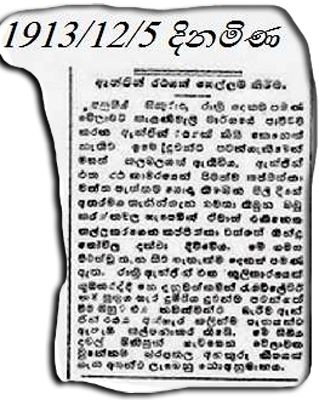News
Strange case of the midnight ghost train
The phone on the desk of the Chief Railway Controller Nihal Ferdinands began to ring at around 1.45 a.m. The caller informed Ferdinands that a runaway train engine sans a driver was moving on the tracks and heading towards the southern coastline at a speed of around 5-10kph.

The Chief Controller recalls that he alerted staff at all stations on the southern route on Thursday night: the instructions were to board the engine at the first opportunity – meaning should it slow down. This, however, did not happen. The British-built engine chugged past station after station as helpless staff looked on and hoped that it would burn up fuel quickly and become demobilised.
“My initial intent was to allow the train to move on to Panadura and derail at some location but an alert official at the railway workshop in Ratmalana thought otherwise,” Ferdinands said. The Chief Controller’s plan was that before the train reached Ratmalana Station it should be switched to a track that headed towards a railway workshop 500m away.
The idea was to ram the runaway engine into the corrugated iron gates of the workshop, hoping it would stall on impact.
Whether the plan would work was an open question because by then the train was moving at a steady 10kph, Ferdinands said.
With the assistance of residents near the station who were by then awake because of the commotion, rail sleepers were placed across the track to slow down the engine before it hit the gates.
While all this was happening, railway technician K. Umayangana positioned himself at a bend in the track where the engine would make the detour towards the workshop, hoping for an opportunity to jump on board the engine. Throwing caution to the winds he made his leap and was able to stop the engine before it crashed into the gates.
The authorities have initiated a full-scale probe to ascertain the circumstances that led to the bizarre happening, only the second such incident in the past 100 years. General Manager Railways B.A.P. Ariyaratne said the relevant driver and assistant on duty at that time had been suspended pending the outcome of the probe.

“Somebody, somewhere, has to take responsibility or else it was a “ghost” happening,” he said. “But at the end of the day it was a happy ending since there was no damage to person or property despite the engine passing several railway crossings on its journey to Ratmalana.” Mr Ariyaratne said this had been the first time he had witnessed such an incident during his many years with the Railway Department and hoped it would be the last.
As news of the suspension of the driver and his assistant emerged, other shunting staff at the Dematagoda Shed went on a brief strike before returning to work several hours later following discussions with management.
Copycat event of 100 years ago
Investigations have found out that a similar freak incident took place during British rule a century ago with a locomotive making a bolt sans a crew on the Kelani Valley (KV) Line in Maligawatte, adjoining Dematagoda. In this case, which occurred, also on a Thursday in December 1913, a coal-powered train engine chugged along for some two kilometres before ramming into several boxes and coming to a halt.

A newspaper carrying the news item


